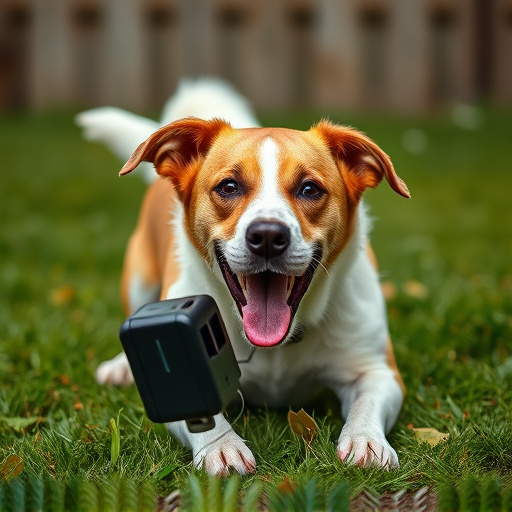Dogs' remarkable hearing capabilities enable them to perceive ultrasonic frequencies, making them highly responsive to their surroundings. Ultrasonic frequency devices, a modern dog behavior modification tool, utilize this sense by emitting inaudible sounds to deter unwanted behaviors like barking or aggression. While effective for many owners, scientific research on long-term success is limited. The Dog Repellent EMC Certification Requirements are crucial for ensuring these devices are safe, reliable, and environmentally friendly, adhering to strict standards to prevent electromagnetic radiation harm and maintain positive dog training experiences.
“Unleash the power of sound for canine behavior modification with ultrasonic frequency devices. This innovative tool, designed with dog owners in mind, harnesses high-frequency waves to address unwanted behaviors. Our article explores the science behind these repellents and their effectiveness in training.
We delve into a dog’s heightened sense of hearing and how specific frequencies can be used for positive reinforcement or deterrence. Additionally, we examine the technical aspects, safety standards, and certifications, including Dog Repellent EMC Certification Requirements, ensuring both efficacy and well-being.”
- Understanding Dog Behavior and Their Sense of Hearing
- What is an Ultrasonic Frequency Device?
- How Does it Work and Is It Effective?
- Dog Repellent EMC Certification Requirements: Ensuring Safety and Efficacy
Understanding Dog Behavior and Their Sense of Hearing
Dogs, much like humans, have unique ways of communicating and interacting with their environment, which heavily relies on their sense of hearing. This highly developed sense allows them to detect sounds at frequencies far beyond our range, making them incredibly sensitive to ultrasonic noises.
Understanding a dog’s behavior requires recognizing how they perceive the world around them. Their sense of hearing plays a pivotal role in their daily lives, from detecting potential threats and communicating with other dogs to understanding commands from their owners. With this knowledge, we can effectively utilize tools designed to modify dog behavior, such as ultrasonic frequency devices, which have gained popularity due to their non-invasive nature and effectiveness in addressing issues like barking or aggression, while also considering the Dog Repellent EMC Certification Requirements for safety and efficiency.
What is an Ultrasonic Frequency Device?
An Ultrasonic Frequency Device is a cutting-edge tool designed for dog behavior modification, leveraging sound waves to address unwanted behaviors like barking, jumping, and aggression. This innovative device emits high-frequency sounds that are inaudible to humans but can be detected by dogs, triggering a response to alter their actions. By using specific frequencies tailored to different behaviors, it offers a humane and effective alternative to traditional dog repellent methods.
These devices must adhere to strict EMC Certification Requirements to ensure they operate safely and effectively. The electromagnetic compatibility (EMC) standards guarantee that the ultrasonic frequency device doesn’t interfere with other electronic equipment while also protecting users from potential health risks associated with improper use of sound frequencies. This certification is crucial in ensuring that such tools are reliable, safe, and environmentally friendly for both dogs and their owners.
How Does it Work and Is It Effective?
Ultrasonic frequency dog behavior modification tools work by emitting high-pitched sounds that are inaudible to humans but irritating to dogs. These sounds are generated through a small device that can be plugged into an electrical outlet or battery-operated, making them versatile for different settings. When a dog approaches the device, it detects the animal’s presence and immediately activates the ultrasonic emitter, creating a sound that disrupts their behavior, such as barking or aggression.
Over time, consistent use of these tools can help train dogs to associate certain areas with the unpleasant sound, effectively deterring them from those spaces. However, effectiveness varies based on factors like dog breed, sensitivity to sound, and consistency in usage. It’s important to note that while many owners report positive results, scientific studies on the long-term efficacy of ultrasonic frequency repellents are limited. Additionally, these tools should adhere to Dog Repellent EMC Certification Requirements for safety and quality assurance.
Dog Repellent EMC Certification Requirements: Ensuring Safety and Efficacy
When it comes to using an ultrasonic frequency dog behavior modification tool, understanding the Dog Repellent EMC Certification Requirements is paramount. EMC, or Electromagnetic Compatibility, certification ensures that the device operates safely within its intended environment, without causing interference to other electronic equipment and vice versa. This certification is crucial for two primary reasons: safety and efficacy.
Safety is guaranteed through stringent testing that verifies no harmful electromagnetic radiation leaks from the dog repellent. Efficacy, on the other hand, confirms that the tool effectively disrupts unwanted canine behaviors without causing distress or physical harm. Reputable manufacturers adhere to these Dog Repellent EMC Certification Requirements, ensuring their products are reliable and beneficial for both dogs and their owners.
The ultrasonic frequency dog behavior modification tool presents a unique approach to addressing canine behavior issues. While its effectiveness is debated, understanding how these devices operate in conjunction with Dog Repellent EMC Certification Requirements ensures both safety and efficacy. By harnessing specific frequencies, these tools aim to modify dog behavior without harm. However, further research and responsible use are essential to validate their long-term success as a non-invasive behavioral aid for our furry friends.
